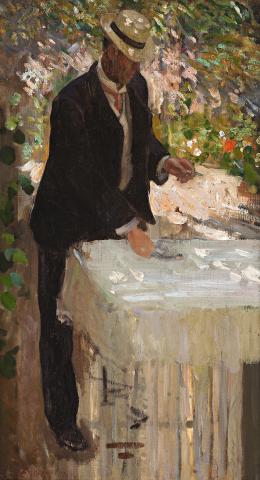FIGURE STUDY FOR THE ARBOUR, c.1909 – 10
EMANUEL PHILLIPS FOX
oil on canvas
74.0 x 40.5 cm
signed lower left: E P[h]illips Fox
Private collection, Brisbane
Private collection, Melbourne
Deutscher-Menzies, Melbourne, 20 August 2001, lot 47 (label attached verso)
Private collection, Tasmania
E. Phillips Fox and Ethel Carrick Fox, Deutscher Fine Art, Melbourne, 13 November – 6 December 1997, cat. 16. p. 21 (illus.)
Zubans, R., E. Phillips Fox: His Life and Art, The Miegunyah Press, Melbourne, 1995, cat. 322
The Arbour, 1910, oil on canvas, 190.5 x 230.5 cm, collection of the National Gallery of Victoria, Melbourne
Life in Paris during la belle époque was elegant, fashions were fabulous, and the pursuit of pleasure was an artful indulgence. Captured by the artists of the day – especially Claude Monet, Pierre-Auguste Renoir, and the Australian expatriates E. Phillips Fox and his friend Rupert Bunny – their colour-filled paintings featured images of relaxation with dappled sunlight highlighting a moment or movement that gave their canvases such Impressionist verve. The artists first sketched in the open air to capture the passing scene or shift of light, and Figure Study for The Arbour, c.1909 – 10 is typically engaging in its immediacy and transience created by swift strokes of the gifted brush. Fox later translated this study into the figure of the man to the left in his masterly painting, The Arbour c.1910, acquired by the National Gallery of Victoria, Melbourne in 1916 through the Felton Bequest. (The Arbour was exhibited at London’s Royal Academy in 1910, and in Paris at the 1912 Salon of the Société Nationale des Beaux-Arts.)
The setting was Fox’s garden in Paris – the sitters members of his family circle, as identified by the noted Fox scholar, Ruth Zubans. The little boy in red, for example, is taken from a study of Len Fox, the artist’s nephew, painted earlier in the home of the artist’s brother David, in Malvern, Melbourne.1 The woman in white with the parasol also had its genesis during this Melbourne visit, the model being David’s wife Ethel. The composition then evolved through numerous sketchbook studies before the finished work achieved its rightful place among Fox’s brilliant déjeuner series – Al Fresco c.1905 in the Art Gallery of South Australia, Adelaide, and Déjeuner c.1910-11 of the Lionel Lindsay Collection, Lionel Lindsay Gallery and Library Trust, The University of Queensland Art Museum, Brisbane.
A subject typical of these graceful times, Ruth Zubans has also drawn attention to the inspiration of Monet and Renoir in Fox’s ‘general response to a lifestyle and the Paris ambience, which perhaps aroused unconscious desires connected to his own past, as well as idealization of family life.’2 The unidentified figure of the man, cigar in hand and suitably attired for the occasion, offers his services to the ladies on the occasion of afternoon coffee.3 Relaxation, family engagement and privacy blend equally. As in this study, the sitters’ glances are kept within the picture’s space. In the final painting, however, any sense of viewer intrusion is set aside by the engagingly direct look of the little boy in his red suit.
1. Zubans, R., E. Phillips Fox 1865-1915, National Gallery of Victoria, Melbourne, 1994, p. 56.
For details of the painting see Zubans, 1995, op. cit., cat. 288
2. Zubans, R., E. Phillips Fox: His Life and Art, The Miegunyah Press, Melbourne, 1995, p. 126. See Monet’s Le Déjeuner c.1873, Musée d’Orsay, Paris, and Renoir’s Le Déjeuner des canotiers, 1881, The Phillips Collection, Washington
3. Previously, this delightful study has been misleadingly titled ‘The Waiter’. However, the dress and manner of the figure are not that of a servant but rather, of an equal member of the party.
DAVID THOMAS
